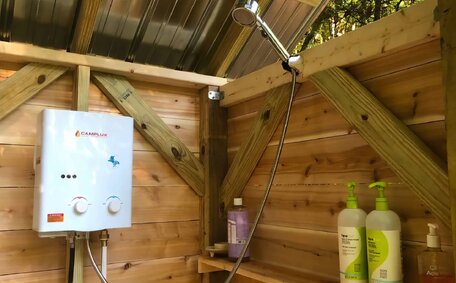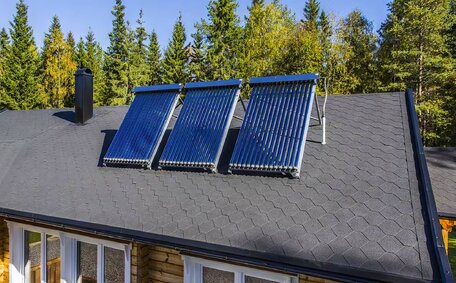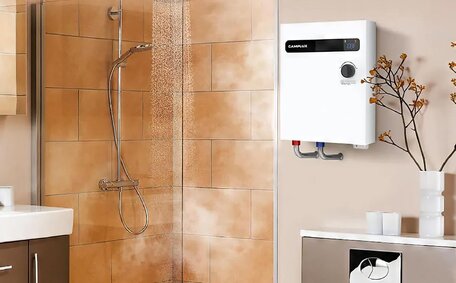Introduction to Hot Water Systems and Temperature Settings
Correctly setting your water heater temperature is vital for ensuring safety and maximising efficiency. Water temperatures that are too high can cause scalding, which poses a risk to vulnerable groups such as children and the elderly, while temperatures too low can foster harmful bacteria such as legionella.
The ideal setting balances these risks while maximising energy efficiency for your homes. A general guideline is to set the hot water temperature at 50°C to inhibit bacteria growth and reduce the risk of burns. However, when determining the best temperature for your electric hot water heater, consider your hot water system type, household needs, and local climate.
In warmer weather, it’s advisable to reduce the hot water temperature to a comfortable level, around 49°C. In colder weather, raising the setting to about 70°C may be necessary to compensate for the increased heat loss from the cold water pipes. Solar systems and electric hot water systems in particular benefit from lower settings around 45-50°C for efficient operation.
A tempering valve guarantees a safe water temperature in your home by automatically blending hot water to a comfortable level before it reaches your taps. Our professional plumber can advise on tempering solutions and give us insights into optimising your water heater’s settings to precisely meet your needs at 50 degrees Celsius.
Health Risks of Incorrect Temperatures
Setting your water heater set below 60°C poses serious health risks, which can include exposure to harmful bacteria. Water heater temperatures below 50°C risk the growth of hazardous bacteria like Legionella, potentially causing Legionnaires’ disease. Legionella thrives in water that isn’t heated sufficiently, which can provoke Legionnaires’ disease, indicating that heating can be a vital preventative measure.
Heaters in storage tanks set below 60°C can create environments conducive to Legionella outbreaks, particularly in hotels, hospitals, and nursing homes. In residential settings, improperly low water temperatures can allow Legionella to contaminate hot water systems.
To mitigate the risk of Legionella growth, maintain your water heater storage temperature at 60°C. Also consider installing a tempering valve preset to 50°C to automatically mix hot water down to a safe temperature before it reaches your taps.
Water temperatures exceeding 50°C present scalding dangers, particularly to children and the elderly. When storage temperatures are set too high, they can waste energy and increase safety hazards, making the temperature too risky for children and the elderly.
Maintaining your hot water heater at 60-65°C strikes a balance between cost-effectiveness and safety for most homes.
Preventing Legionella Bacteria Growth
Legionella bacteria pose a concerning risk in your heaters if temperatures drop too low. Legionella can cause Legionnaires’ disease, a serious lung infection. To prevent growth, hot water systems should maintain temperatures above 60°C.
Set hot water temperatures above 60°C where Legionella cannot survive. Water temperatures below 60°C can accelerate Legionella growth, especially in areas with little water circulation. Hot water heater tanks can become high-risk areas for Legionella if the water temperature settings are too low.
Aim to ensure hot water heater temperature is maintained within a 60-65°C range for optimal safety and efficiency. While higher temperatures can diminish Legionella risk, they may also raise energy costs and scalding hazards in your hot water system. Installing a tempering valve preset to 50°C can also provide the best solution for delivering safe yet comfortable hot water to taps.
During periods of low water usage, adjust the size of your hot water to reduce Legionella risk, which can include flushing stagnant pipes. Prevent bacteria growth by draining systems, flushing pipes, and occasionally increasing temperatures to 60°C or above to eliminate bacteria.
Maintaining vigilance is key to ensure your safety and the efficiency of your heating system. Check your water heater temperatures monthly, ensuring they are at least 60°C, and service heaters yearly. If your system falls below 60°C, take corrective action immediately to control Legionella risks.
Avoiding Scalding and Burns
Setting water temperatures too high increases risks of scalding and burns. Australian Standards specify the required duration for tempering valves to prevent injuries in high-risk settings.
Tap water over 50°C can cause serious scalds, especially affecting those who are vulnerable like children and the elderly. Tempering valves are required in early childhood centres and nursing homes to automatically mix hot water down to a safe temperature, reducing the risk scalding.
Even in private homes, aim to temper stored hot water to 50°C at taps through thermostatic mixing valves. These provide whole of home protection to avoid scalds. Consider tempering valves if you have young children or mobility-impaired occupants.
Ensure to adjust the temperature your water heater via the tempering valve to target a safe 50°C at sinks and basins. For your showers and baths, setting the temperature your water should reach via the tempering valve to 45°C is safer to allow for heating during transfers between outlets and fixtures while avoiding injury risks.
Installing a tempering valve can let you safely increase hot water storage temperatures while delivering tap water at the desired temperature level. This provides Legionella control alongside scalding protection for improved safety.
Achieving Efficiency and Saving Money
Setting your hot water system to the optimal temperature setting can significantly impact energy usage and costs. There are several steps you can take to maximise efficiency:
- Minimise standby heat loss by insulating your hot water system, tanks, and exposed pipes with insulating jackets. This also keeps water hotter for longer during high demand periods.
- For electric water heaters, the Department of Energy recommends setting temperatures between 45-50°C to optimise collector efficiency. Higher settings cause excessive cycling which drives up power use and can surge energy back into the grid.
- Consider the size of your gas water heater tank and usage needs carefully when choosing a new system. Oversized units waste more energy reheating your hot water tank during low demand times.
- Set your water-saving devices like shower heads and tap fittings for efficient water heaters. Finding ways to lessen your hot water consumption equates to reduced reheating and energy expenditure.
- Set the temperature on your thermostat to 60°C during warmer months and before extended away periods when legionella risks are reduced, which can save energy your water heater uses. This setting cuts heat losses.
During winter, increase your water heating temperature to 65°C to compensate for greater heat loss through the pipes. Just ensure water is supplied at your desired safe temperature to fixtures to prevent scalding.
With some smart tweaks, you can save money and energy while enjoying your hot water tank safely year-round.
Adjusting Settings by Season
Outdoor temperatures influence the performance of hot water systems and their optimum settings. In colder months, increase the thermostat to 65-70°C to offset greater heat losses from cold water pipes after heating. You may also need to adjust the flow rate to provide sufficient hot water delivery.
During warmer months, setting your water heater to around 60°C can help prevent Legionella and maintain a comfortable water temperature. Take care to drain and flush systems when you’re turning off heating for extended vacant periods to prevent bacterial growth in stagnant water.
During winter, especially in alpine areas, take measures to prevent freezing in external pipes and fittings, such as ensuring a constant flow of warm water:
- Ensure proper insulation for exposed pipes
- Ensure the water heater thermostat is set to a minimum of 60°C
- Let tap farthest from heater run at trickle overnight on very cold days
Adjust season-specific settings to ensure water reaches an optimal temperature, maximising efficiency, comfort, and safety. Temperatures between 60-65°C balance energy use, Legionella risks and supply needs over changing ambient conditions. Installing a tempering valve preset to 50°C also helps automatically compensate for variable tank thermostat settings.
Using Tempering Valves
A tempering valve serves as a crucial safety device, maintaining safe water temperatures by mixing hot and cold water before it’s delivered to taps and appliances.
By blending hot tank water down to a more tepid level around 50°C, tempering valves help prevent accidental scalding while allowing you to adjust your water heater temperature to maintain needed levels to control Legionella bacteria growth.
Tempering valves maintain a consistent, pre-set outlet temperature, efficiently blending your hot water. This overcomes variations from seasonal changes or peak usage in larger households.
Some key benefits of tempering valves include:
- Ensuring water is tempered to safe levels in compliance with Australian Standards to prevent scalds and burns
- Facilitating higher storage temperatures for efficient reheating, while ensuring that tap water remains temperate and comfortable
- Offering precise and consistent temperature control despite varying tank settings or specific household requirements
By installing a tempering valve preset to 50°C, your family can enjoy endless hot water with full Legionella control, while eliminating risks of injury from dangerously high temperatures at fixtures. This futureproofs home safety while controlling energy costs.
As professional plumbers, we expertly install and adjust tempering valves tailored to your household requirements. Contact us today for guidance on tempering solutions or any inquiries regarding your hot water system.
Tips By System Type
The ideal temperature settings for hot water systems depend on the type of system you have:
Electric Storage
- Aim for 60-65°C in water heating to balance bacteria control and efficiency.
- Efficiently manage water demand and minimise standby heat loss by insulating tanks and pipes.
- Properly sizing your storage hot water tank is crucial; oversized tanks lead to excessive energy waste during reheating.
Gas Storage
- 60-65°C is optimal for Legionella control and efficiency.
- Pipe insulation reduces heat losses between tank and fixtures.
- Clean the burner yearly and replace Anodes, ensuring there are no more maintenance oversights.
Solar Hot Water
- Set your system to 45-50°C for optimal collector efficiency, whether it’s electric or gas.
- Electric or gas booster handles periods of low solar gain.
- Consider mixing valve if tank temperature exceeds 50°C.
Heat Pump Systems
- Set to 45-50°C to maximise operating efficiency.
- Use within heat pump’s optimal ambient temperature range.
- Requires minimal piping distances between tank and heat into unit.
Fine tuning your system’s settings delivers optimal temperatures for health, efficiency and comfort all year round. Contact our team to learn how adjust your hot water system for optimal performance.
Professional Maintenance
It’s essential to have your hot water system professionally serviced annually; give us the opportunity to ensure optimal temperature control and prevent issues. Our licenced Cranebrook plumbers can conduct a complete inspection of your system to check it is operating safely and efficiently.
An annual service allows us to clean and adjust components like burners, thermocouples, anodes and relief valves. We also check insulation, thermostat calibration, water quality and signs of leakage. Any problems identified can be promptly repaired to restore performance, which is something our experienced team can do efficiently.
Our decade-plus plumbing experience equips us to handle all types of systems. Do you need a repair or system maintenance? Our plumbers offer same day service, arriving promptly with fully-stocked vans, ready to tackle any issue from circuit breaker tripping to pipe leaks during repairs on initial callouts. Urgent jobs and after-hours issues are our specialty with 15 minute response times.
Don’t risk injury or discomfort – give us call to secure endless hot water at the proper temperature with our trusted service. Contact Cranebrook Plumbing on 1300 349 338 or email to book your annual maintenance check.






